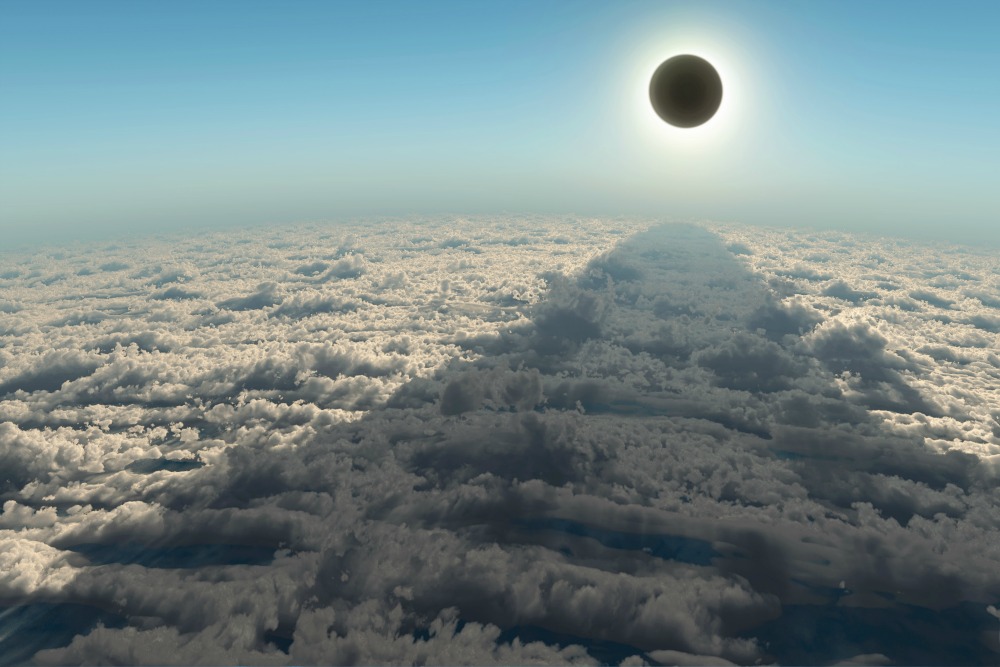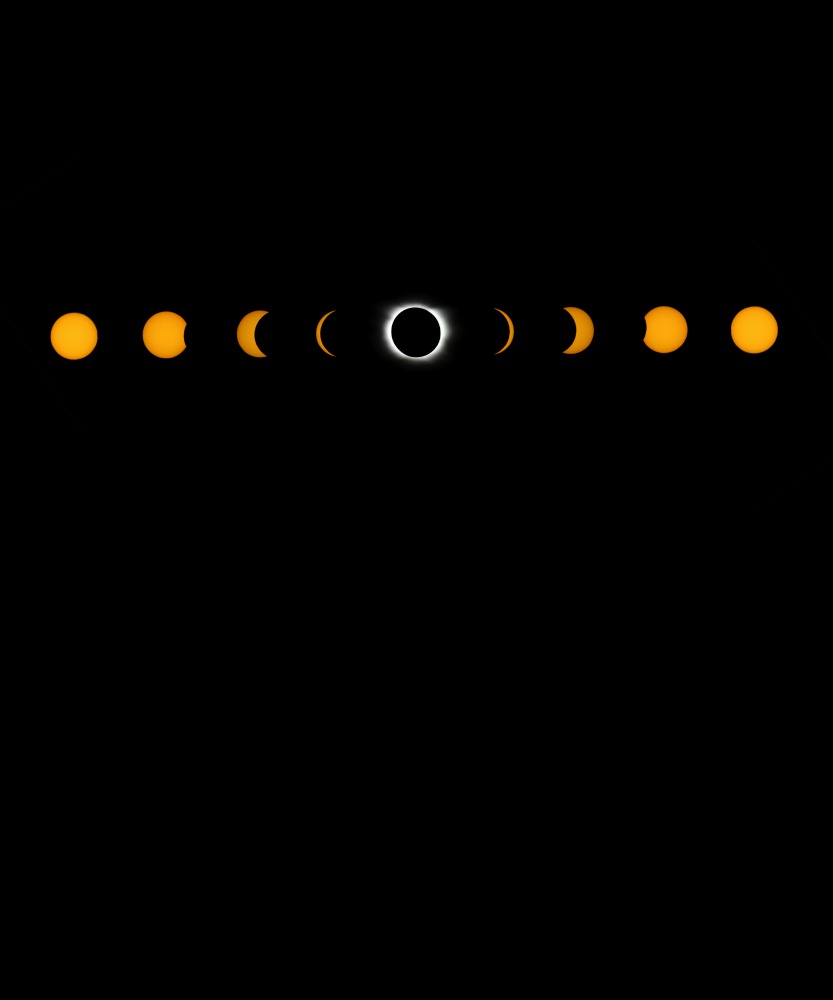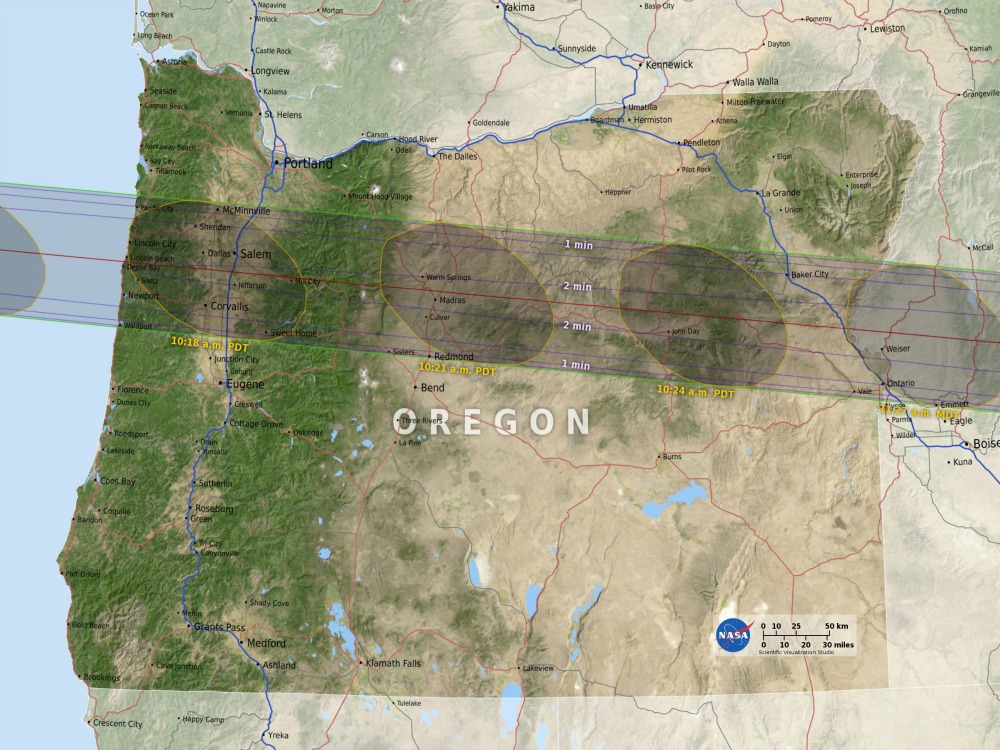HEY YOU, LOOK UP!
WHAT: Total Solar Eclipse—the first to be on the continental U.S. since 1979.
WHEN: August 21, 2017; the event will last, depending on where you are in the umbra (moon’s shadow—a 60-mile-wide swath), anywhere between one minute and 55 seconds to two minutes and 40 seconds.
WHERE: Beginning in the Pacific Ocean, the eclipse will hit the U.S. on the Oregon coast and travel through Idaho and Wyoming before heading south to leave the U.S. on South Carolina’s coast.
The natural event will last a total of 1h 33m 16sec in the U.S. and will travel across 14 states before hitting the Atlantic Ocean and disappearing off the Earth’s surface near Africa. 222 million people (or 68% of the nation) will be within a one- or two-day drive (500 miles) of this central path. There will be eclipse chasers, astrophysicists, NASA scientists, amateur astronomers, astrophotographers, night sky lovers, and everyone in between who will stand outside and look up (with proper eye protection) on this summer day to witness and document the uncommon experience first-hand.
Those who have experienced eclipses remark that it is incredibly emotional, not only because they are watching the solar system in action, but also because the memory of the spectacle is otherworldly and virtually impossible to forget. There’s every reason to prepare for this planet party by educating yourself with a few facts and participating in this phenomenon that is sure to be the basis for the question of the 21st century! “Where were you for the solar eclipse?”
WHAT IS AND WHAT HAPPENS DURING A SOLAR ECLIPSE:
The Sun is 400 times larger than the Moon and also 400 times farther away from the Earth. They look like the same size in our sky, which is why we can witness this astral event. Without this precise ratio, there would be no solar eclipses. A solar eclipse occurs when the Moon is between the Earth and the Sun, and its shadow hits the Earth. If you’re in the shadow (umbra), you’ll see the eclipse. While you’re on top of a peak, in the middle of a field, or in the center of town, here are some viewing tips:
- All phases (partial and total) of the eclipse could last up to three hours. Again, this depends on where you’ll be viewing it. Everyone in the U.S. will be able to see a partial eclipse. Savor each phase and be sure to keep your safety glasses on during all of them except for the total eclipse where you can remove them for the length of totality. NEVER use eclipse glasses with binoculars or a telescope.
- Baily’s Beads are what appear to be a ‘string of beads’ during the last moments of the sun’s crescent before the totality. The beads are actually the low-lying valleys on the Moon’s edge that allow the sunlight through.
- The diamond ring is the final glimpse of sunlight that passes between the Moon’s craters and mountains before the first glow of the corona.
- Did you know that 2,000,000°F is the temperature of the hot plasma corona around a total solar eclipse, while the average decrease in temperature caused by a total solar eclipse is 20°F? You’ll definitely notice the lower temperature and, possibly, changes in the behavior of your animals or surrounding wildlife.
- The corona is the radiant crown of hot gas (its atmosphere) that surrounds the sun, but which we ONLY SEE during a solar eclipse. This halo of shimmering brilliance is what changes eclipse viewers into eclipse chasers. It’s that mesmerizing.
- Look all around because you might see shadow bands on the ground and you may notice the sky’s apparent 360° sunset, which will be brighter to the north and south. And, take two seconds to find Venus, which will be to the right of the totality and the brightest planet in the sky.
- Come prepared to gaze and picnic. See our Solar Eclipse Picnic List. And, remember why you’ve come outside—to enjoy what could be a once-in-your-lifetime phenomenon, i.e. you and a solar eclipse may not meet again.
ECLIPSE JARGON:
You remember science class, where you studied astronomy and learned about stars, comets, black holes, and galaxies. You probably crammed for a test and aced it, but if you had to do it all over today, you might want this glossary as a tune-up for understanding the celestial phenomenon known as the solar eclipse.
Annular Eclipse
A solar eclipse that occurs when the apparent size of the moon is not large enough to completely cover the sun. A thin ring of very bright sunlight remains around the black disk of the moon.
Anomalistic Month
The time it takes for the moon to orbit Earth from apogee to perigee and back to apogee.
Aphelion
The point in an object’s orbit when it is farthest from the sun. Currently, Earth reaches aphelion in July.
Apogee
The point in an object’s orbit when it is farthest from Earth.
Astronomical Unit
The average distance between Earth and the sun (149,597,870 km or 92,955,807 miles).
Baily’s Beads
The effect seen just before and just after totality when only a few points of sunlight are visible through valleys around the edge of the moon.
Central Eclipse
A solar eclipse in which the central axis of the moon’s shadow traverses Earth. Central solar eclipses can be total, annular, or hybrid.
Chromosphere
The lower atmosphere of the sun just above the photosphere that appears as a thin crimson ring around the edge of the sun during a total solar eclipse.
Contact
One of the instances when the apparent position of the edges of the sun and the moon (for eclipses) and the sun and a planet (for transits) cross one another. They are designated as first, second, third, and fourth contact.
Corona
The upper atmosphere of the sun. It appears as a halo around the sun during a total solar eclipse.
Diamond Ring
The effect seen in the few seconds just before and after totality of a total solar eclipse when there is a single point of sunlight brilliantly shining through a valley on the limb of the moon.
Eclipse
The alignment of celestial bodies so that one is obscured, either partially or totally, by the other.
Gibbous
Phase of the moon when it appears more than half illuminated.
Hybrid Eclipse
A solar eclipse which appears annular or total along different sections of its path.
Lunar Eclipse
The passage of the moon into the shadow of Earth, which can only occur at a full moon.
Magnitude (of a solar eclipse)
The fraction of the apparent diameter of the sun covered by the moon. By convention it is usually quoted at maximum phase.
Obscuration (of a solar eclipse)
The fraction of the sun’s area covered by the moon.
Partial Lunar Eclipse
A lunar eclipse where a portion—but not all—of the moon enters Earth’s umbra.
Partial Solar Eclipse
A solar eclipse seen from within the moon’s penumbra. The moon appears to block part—but not all—of the sun’s photosphere.
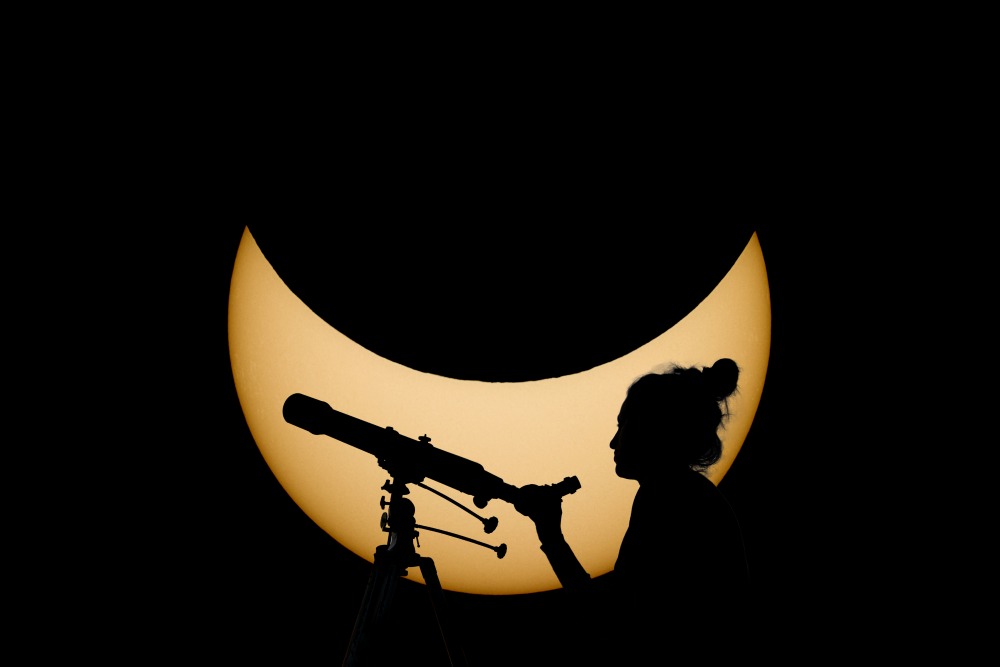
Path of Totality
The path (up to about 270 km or
168 miles wide) that the moon’s shadow traces on Earth during a total solar eclipse.
Penumbra
The part of a shadow—as of the moon or Earth—within which the source of light, such as the sun, is only partially blocked. Also, it refers to the lighter outer area of a sunspot.
Perigee
The point in an object’s orbit when it is closest to Earth.
Perihelion
The point in an object’s orbit when it is closest to the sun. Currently, Earth reaches perihelion in early January.
Photosphere
The bright, visible surface of the sun.
Prominence
A large-scale gaseous formation above the surface of the sun shaped by the sun’s magnetic field.
Saros
The eclipse cycle, which has a period of 223 synodic months or 6,585.32 days—the equivalent of 18 years and about 11.3 days.
Shadow Bands
Faint ripples of light sometimes seen on flat, light-colored surfaces just before and just after totality.
Solar Eclipse
The passage of the new moon directly between the sun and Earth when the moon’s shadow is cast upon Earth. The sun appears in the sky either partially or totally covered by the moon.
Solar Flare
An explosive eruption in the sun’s atmosphere.
Sunspot
A magnetic disturbance on the sun that appears as a dark blotch on its surface.
Terminator
The edge between night and day on the moon or a planet.
Total Solar Eclipse
A solar eclipse seen from within the moon’s umbra. The moon appears to completely block the sun’s photosphere.
Totality
The period during a solar eclipse when the sun’s photosphere is completely covered by the moon and the period for a lunar eclipse when the moon is in the complete shadow of Earth.
Umbra
A complete shadow—such as that of the moon or Earth—within which the source of light, such as the sun, is totally hidden from view. Also, it refers to the dark inner area of a sunspot.
© “Total Solar Eclipse 2012 Education Resources.” Astronomical Association of Queensland; Science Teachers Association of Queensland, 2012. Web.
FROM THE PACIFIC COAST TO THE COWBOY STATE, HERE’S WHAT’S HAPPENING IN THE MOUNTAIN WEST!
OREGON
The glorious umbra hits land at 2,955 MPH and cloaks Lincoln Beach and Depoe Bay in darkness at 10:16am. While moving across the state to such towns as Corvallis, Lebanon, and Salem, the shadow decreases in speed. About four minutes later, eclipse worshippers in Madras and Warm Springs will have their wishes granted before the shadow says goodbye to the Beaver State near Ontario and makes its way to Idaho.
Total Time In Oregon: 9m
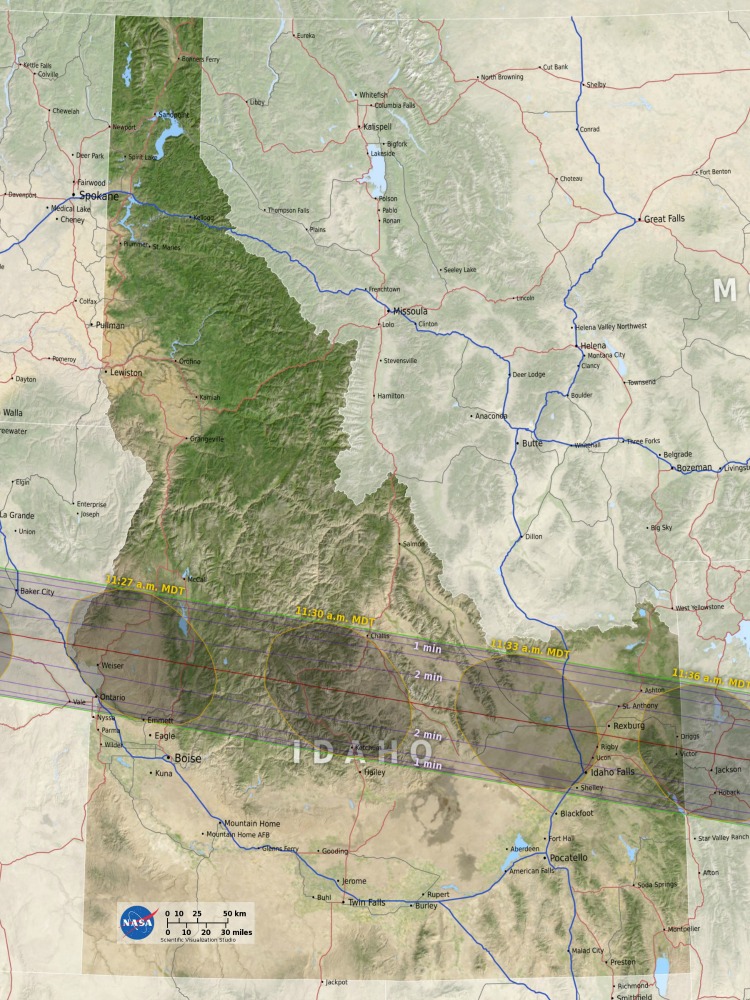
IDAHO
The eclipse appears over Weiser, Idaho, and heads to the Sawtooth Range in the central part of the state where weather forecasters believe that Stanley, a small town in a valley off Highway 75 will likely prove one fascinating area because of its proximity to the central line. August sunshine averages make Idaho a stellar state for viewing and Mackay, Idaho, is another small town near the center of the path of totality. Sun Valley is planning a celebration as well. In eastern Idaho’s Teton Valley, (the home of Victor, Driggs, and Tetonia) spends 2:18 in beautiful twilight, which accounts for the throngs of international, national, regional, and local travelers who have pinpointed this area as a prime viewing spot. Although the Teton Range produces significant weather patterns, eclipse watchers believe the valley’s temperature and the eclipse’s cooling will eat up any morning convective clouds. Get in the path!
Total Time In Idaho: 9m 35s
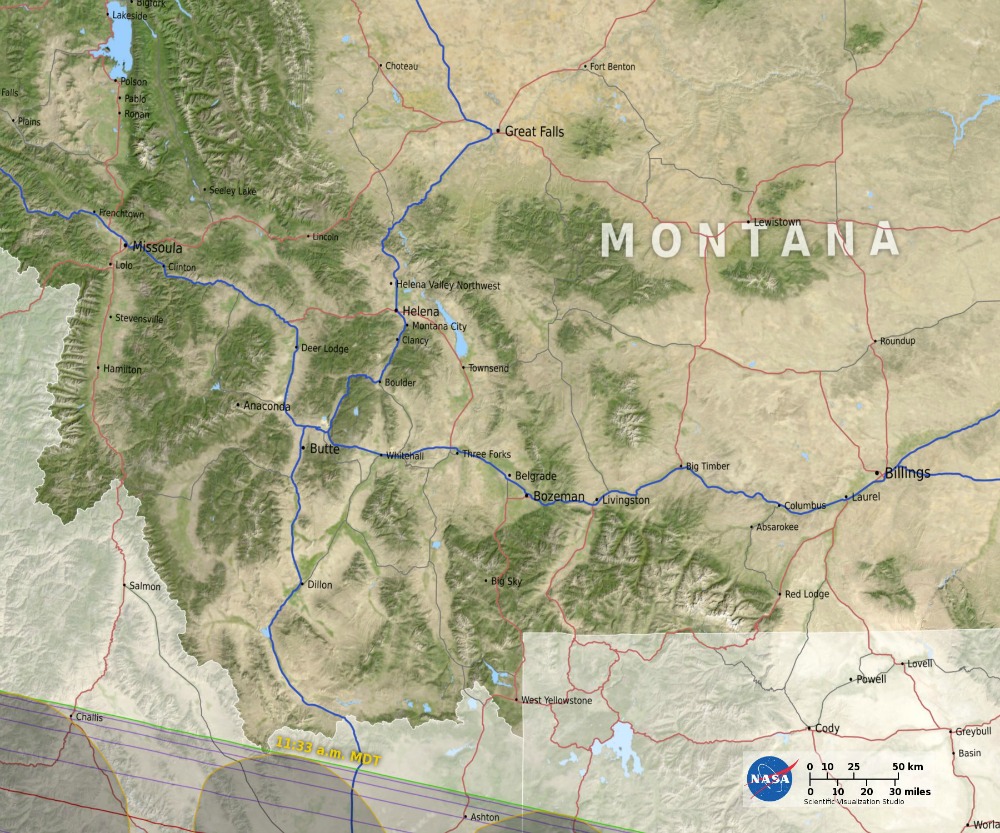
MONTANA
The Big Sky state is one of two states (the other is Iowa) in the path where there are no populated areas that see the umbra, unless of course you happen to be in the eight square miles of the southwestern tip known as the ‘beard.’ Climb the Italian Peaks in this remote wilderness area if you’re up for it.
Total Time In Montana: 45s
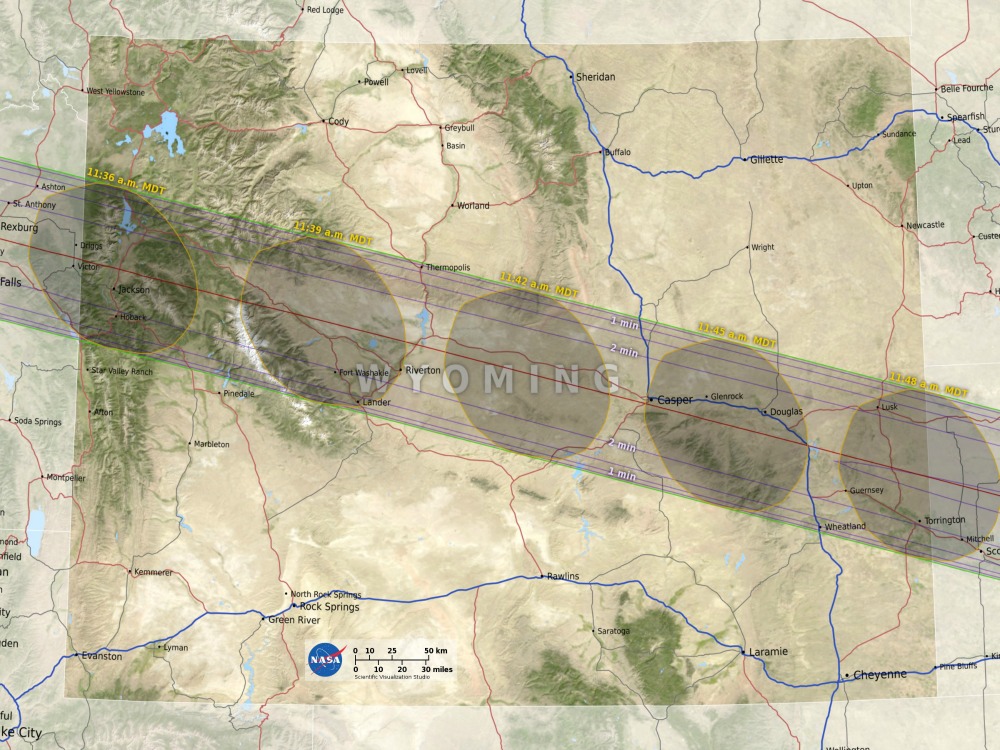
WYOMING
Head either to Teton Village (the home of Jackson Hole Mountain Resort) or to Grand Teton National Park. Purchase your tram ticket from Jackson Hole Mountain Resort and you’ll be standing atop Rendezvous Peak for this Great American Eclipse. Serious astronomers and eclipse chasers booked their accommodations up to three years ago, which is why the town of Jackson is estimating an additional quarter- to half-million visitors for this event. Reminder: the eclipse in Jackson will come from the southeast and it will be very difficult to create a photograph to include the Tetons. Further east, Casper will experience 2 minutes 26 seconds of bliss spread out over the high desert terrain. The location is so good (access to highways in case the weather changes), that the Astronomical League’s annual convention, Astrocon, will be held there. Wyomingites know how to party, so get ready for the Wyoming Eclipse Festival. More details in our Eclipse Party section below!
Total Time In Wyoming: 12m 39s
Onward and across the U.S., the moon’s umbral shadow will travel to Nebraska, Kansas, Missouri, Illinois, Kentucky, Tennessee, Georgia, and North and South Carolina. Wherever you happen to be, plan to be in the path!
Shadows chase earth. Darkness consumes light. Chill replaces warmth. The natural world pauses in uncertainty and humanity tilts its head to the sky. What’s next is a primal reaction to the immersive experience from this stunning spectacle, which typically evokes intense emotion. It’s a rare occurrence that is impossible to forget and one that some chase their entire lives. The Great American Eclipse is the first solar eclipse visible from the continental U.S. since 1979. No wonder we’re all excited.
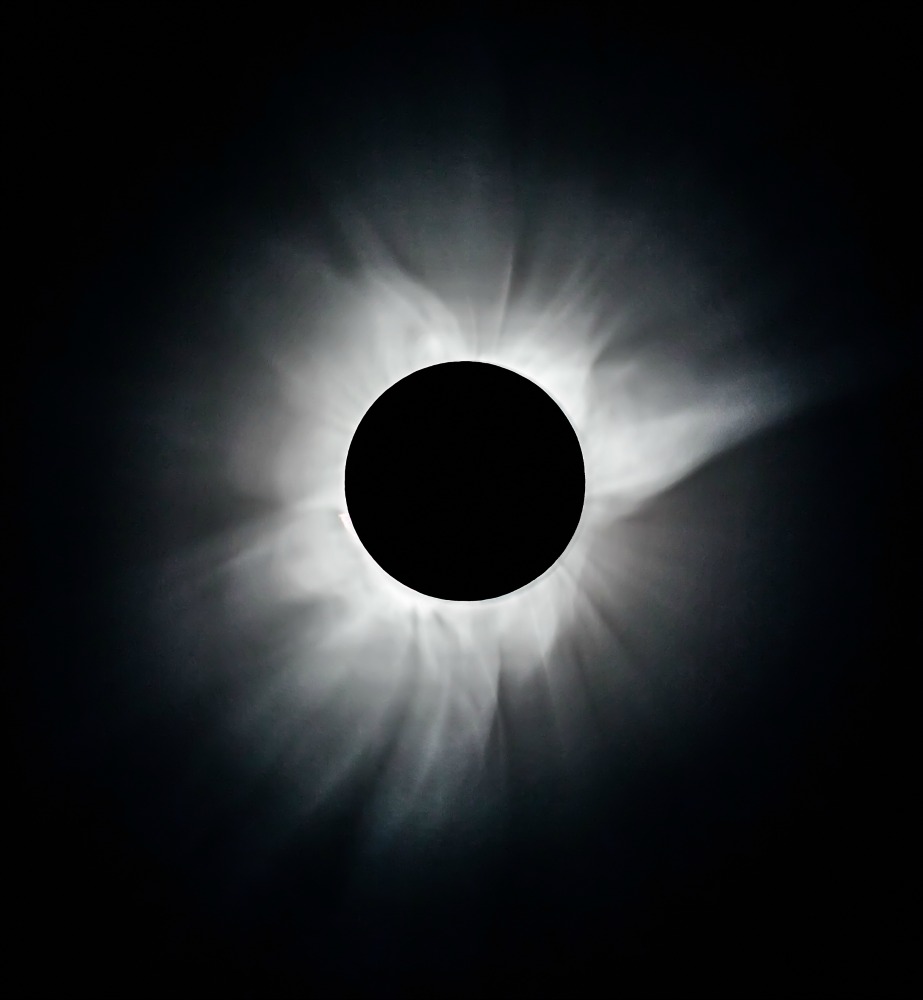
SOLAR ECLIPSE PARTIES:
OREGON
Oregon Solarfest
(NASA Official Viewing Site)
August 17-22
Madras is offering the “Home Away from Home” package, which includes a Festival Grounds Apartment Container (which sleeps 2-4 with private bath), festival tickets, parking for one vehicle, shuttle passes, Kids Dome passes (if needed), and viewing glasses. With three days of music and entertainment, hot air balloon rides, and NASA-provided education, you can bet this is one hot spot! oregonsolarfest.com
Oregon Eclipse 2017
August 17-23
Big Summit Prairie in the Ochoco National Forest is a 55,000-square-foot private ranch with campgrounds, forested areas, and a 52-acre lake. With seven live stages, large-scale art installations, and more, this week-long celebration provides first-come, first-served camping and supported transportation from Portland, Bend, and Redmond airports. oregoneclipse2017.com
IDAHO
Sun Valley Resort
Visit Sun Valley Resort and get to the top of Bald Mountain via lift or gondola. The Resort’s offering a Black Diamond package with priority Gondola loading, a buffet and bar, and parking. The towns of Ketchum and Sun Valley are hosting a party at Festival Meadows. Want more nature? Drive over Galena Pass into the Sawtooth Mountains to Stanley. It’s touted as an excellent location and will receive 2m 13s of totality. sunvalley.com and stanleycc.org
Teton Valley
Teton Valley has reasonably priced 4-, 5-, and 6-night camping packages in Northwest Victor (Buckskin Loop + S1750W). B/L/D will be served at their hospitality site in Pioneer Park. Another option: Get up high and take your party to Grand Targhee Resort where a limited number of camping, parking, and lift tickets will be available. The views on the ‘quiet side of the Tetons’ are magnificent. tetonvalleyeclipse.com and grandtarghee.com
WYOMING
Wyoming Stargazing
Wyoming Stargazing offers a weekend of pre-eclipse fundraising parties where you can chat with retired NASA Astronaut Scott Altman on the top of Snow King Mountain and hear presentations from astrobiologist David Grinspoon and supernovae expert Douglas Leonard. Transportation is provided from your home or hotel and lift tickets are included in the price. And, on Eclipse Day, in partnership with Spring Creek Ranch, Wyoming Stargazing is hosting a gourmet brunch, exclusive presentations from astronomers and resident naturalists, and access to high-end optics. Book it! wyomingstargazing.org
Jackson Hole Mountain Resort
JHMR is a great place to be for the eclipse with a few viewing options. If you choose the tram, you’ll be whisked to the top of Rendezvous Mountain. Have a snack at Corbet’s Cabin while you drool over the outrageous views. The Sweetwater Gondola offers first-come, first-served sightseeing for ticket holders where Casper Restaurant will be open for food, drinks, and restrooms. Both tram and gondola tickets come with viewing glasses, and both begin transport at 8am and both download from 12-4pm. There is a free designated viewing area next to the Ranch Lot on the northeast corner of Teton Village. After the eclipse, Pinky & the Floyd perform at 2pm. Note that all lift access will be ticketed in advance. jacksonhole.com
Four Seasons Hotel and Residences
The Four Seasons has teamed up with astronomy team Teton Skies for a private viewing party hosted at Jackson Hole Mountain Resort’s Rendezvous Lodge (also known as Piste Bistro). After a ride up Bridger Gondola (9,095’), guests can choose between indoor seating or an outdoor patio with dramatic views of the valley and adjacent mountains. Catered by world-class chefs, there will be food stations and an open bar of mimosas and bloody marys. Teton Skies’ astrophysicist Ryan Hennessey will hold a discussion of the stages and each guest will partake in an exceptional viewing experience using state-of-the-art hydrogen-alpha solar telescopes. Leading up to the event are culinary, musical, and educational activities. Limited tickets. fourseasonsjacksonhole.com
Wind River Eclipse
The “Winds,” or Wind River Range, contains 19 of Wyoming’s 20 highest peaks. Several gatherings are scheduled including the Grizzly Rock Ranch’s 7th Annual Rocking the Winds Benefit Fundraiser with live music. There are designated eclipse guided trips with the Lander Llama Company and Outfitters of the Wyoming Wilderness where both situate you and your crew at over 10,500 feet. These gatherings can be small or large depending on your party style, so choose accordingly. windrivereclipse.org




